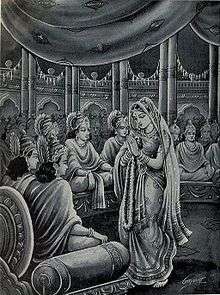Swayamvara
Swayamvara (Sanskrit: स्वयंवर, IAST: svayaṃvara), in ancient India, was a practice of choosing a husband, from among a list of suitors, by a girl of marriageable age. In this context, "swayam" in Sanskrit means self and "vara" means groom.

In this practice, the girl decides to conduct the Swayamvara of the daughter at an auspicious time and venue, and broadcasts the news of this to the outside world. Kings typically used to send messengers to outside lands, whereas commoners arranged to spread the news within the local community.
On the appointed day and venue, the girl chooses from an assembly of suitors, or the suitors by completing a task. When the girl identifies the husband of her choice, she garlands him and a marriage ceremony is held immediately.
Examples
Sīta
In the Hindu epic Ramayana (रामायण), Sītā (सीता) marries Rama (राम), the only one strong enough to lift the Shiva Dhanush (Lord Shiva's bow) and string it. There is mention of swayamvara in Valmiki Ramayana.[1] but in Tulsidas Ramayan Ram Charit Manas this swayamwara is described. In Valmiki Ramayana, King Janak proclaims that he has promised that Sita will be wed to the person who can lift dhanusha and string it. Rama was the only one to accomplish the task of both lifting and being able to string the bow. This condition of lifting dhanusha was called by Janak as virya shulka, meaning the cost to be paid by suitor for marrying Sita.
Kunti
King Kuntibhoja arranges a swayamvara for his adopted daughter Kunti in the Hindu epic Mahābhārata. Many kings and princes from the Aryan region attended her swayamvara. Among them was Pandu, the king of Hastinapura. Kunti chose Pandu as her husband.
Draupadī

For Drāupadī (द्रौपदी), the daughter of King Drupada of Paanchal in the Mahābhārata (महाभारत), aspirants had to hit a fish's eye with a bow and arrow. This fish was just an image on a rotating wheel, which was rotating on a rod. The rod was placed in a pan filled with oil. The many suitors had to pierce the eye with a bow and arrow only using the reflection created by the water in the pan. Only three men of marriage age in the world could do it. They were Hastinapur Prince Arjuna, the third among the Pandava in incognito, King Karna of Anga and Prince Krishna of Dwapara. But Krishna was there only as a spectator and to ensure that Arjuna married Draupadi. Though Karna was highly qualified and capable, Draupadi rejected his chance when approached the challenge, stating his low birth caste as a charioteer made him unworthy to marry a god-born princess like her. This was the reason that Karna developed great hate towards Draupadi. Arjuna succeeds in hitting the fish and marries her.
Damayanti
Another famous swayamvara from the Mahabharata is found in the story of Damayanti, who chooses Nala for her husband, against the wishes of the gods.
Modern literature
The Bearded Prince tells the story of Princess Roopali, whose father holds a swayamvara for her to select her groom.[2]
Roshani Chokshi's The Star-Touched Queen has the heroine Maya's father stage a swayamvara for her early in the novel.
Kitayun
The Shahnama of Fardausi records a similar tradition in pre-Islamic Iran, of one Kitayun, eldest daughter of the Emperor of Constantinople, selecting the Iranian Gushtasp. With a view to procure a husband for one of his daughters, the Emperor determines to hold a grand assembly of illustrious and wise men for her to see and select from. She does not find a suitable husband in the first assembly and a second one is held, where she places the crown on Gushtap's head. Gushtasp, also known as Vishtaspa, returns to Iran with his bride and is crowned King.[3]
As per the custom of Rum, when a princess reached marriageable age, all the princes and nobles would gather in a hall where the princess would enter with her handmaidens and would select one of the princes to be her husband.[4]
Rum (literally "Rome") was the common name used for the Eastern Roman Empire or Byzantine Empire by Middle Eastern people.[5]
See also
References
- "I was given thus to Rama in that Svayamvara, a process of self-choosing marriage. I became devoted, by my good works, to my husband who is excellent among men of strength."http://www.valmikiramayan.net/ayodhya/sarga118/ayodhya_118_frame.htm
- https://www.forewordreviews.com/reviews/the-bearded-prince/
- The Shah-Namah of Fardausi, translated by Alexanders Rogers, LP Publications page 280
- Mazda-Yasni and Zorastranian Tales (Book Two) as retold by Kuku S Shabbir, PAGE 28, ISBN 81-85684-06-5, ISBN 81-85685-01-0,
- Mazda-Yasni and Zorastranian Tales (Book Two) as retold by Kuku S Shabbir, Page 33, ISBN 81-85684-06-5, ISBN 81-85685-01-0